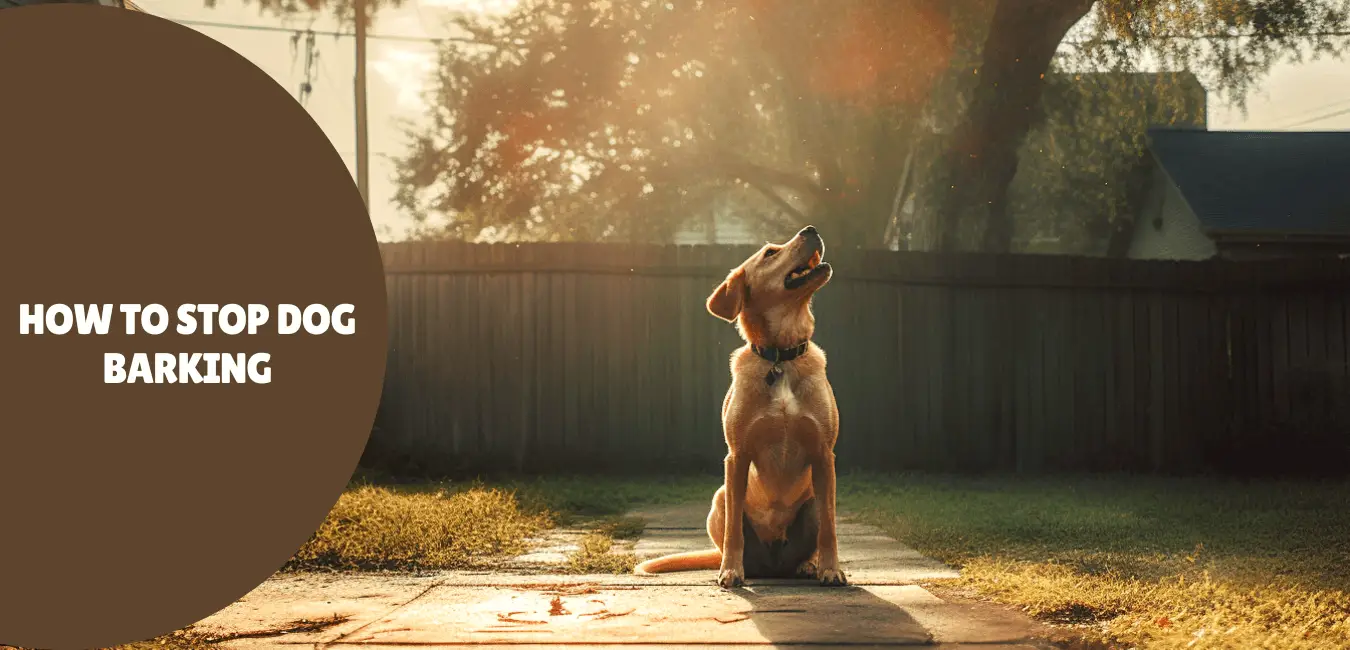To identify the reason for barking in your dog when dealing with excessive barking, understanding dog behavior and analyzing the environment are necessary solutions. In this section, we will explore these sub-sections briefly, which will help you determine why your dog is barking excessively.
Contents
Understanding Dog Behavior

Comprehending Canine Conducts
Grasping dog behavior is crucial to keep them in good health and joyous. To attain this, it is essential to decipher the cause of their behavior. Barking is one of the most frequent behaviors dogs express. This could be a sign of different expressions like attention-seeking, nervousness, or territorial aggression.
To comprehend a dog’s behavior properly, observe their body language and the sound of their bark. Figure out if it’s a warning bark or just an amiable greeting. A study by Alexandra Horowitz uncovered that dogs have varied vocalizations for various emotions they sense.
It is also important to bear in mind that some elements might influence barking, such as environment and breed-specific traits. A Chihuahua would bark more than a Basset Hound due to its excitable character.
Did you know that barking is a type of expression developed by canids? Rather than blaming your dog for barking too much, consider the environment and see if it’s only trying to inform you about the neighbor’s suspicious van.
Analyzing the Environment

Analyze the Soundscape to Determine Why Your Dog Barks.
Identify any sounds or stimuli that might cause your pup to bark, such as vacuum cleaners, doorbells, and car horns. Check the area where your dog usually stays and adjust it for less noise.
Look for weather conditions that could trigger barking. For example, when wind causes windows and doors to slam shut. Observe your pet’s body language to know why they bark – e.g. if it’s because they are anxious or playful.
Exercise your dog regularly and keep an eye on their behaviour changes. This can help you spot patterns that lead to barking. Teach your dog that silence is golden. Otherwise, they’ll end up in the doghouse!
Train the Dog to Stop Barking
To train your dog to stop barking, use positive reinforcement techniques and clicker training as solutions. Positive reinforcement techniques encourage and reward good behavior, while clicker training uses a clicker to mark the desired behavior and reinforces it with a treat. In this section, we’ll explore the benefits of each technique and how they can help you train your dog to stop barking excessively.
Positive Reinforcement Techniques
Quiet Your Dog’s Barking with Positive Feedback!
Reward your pup every time they stop barking on command. Start with a simple word or phrase and give treats or praise when they obey.
Increase the difficulty by using the same command in different situations.
Other ways to show positive feedback are playing with their favorite toy or ignoring unwanted behavior.
Be patient and consistent in training. Clicker training can be a fun way to make strange noises in public without getting strange looks!
Clicker Training
Achieve a quiet home with Effective Dog Communication! Clicker Training is the key to resolving barking issues. Clickers are devices that signal positive behavior with distinct sounds. This earns rewards for your pet, while reinforcing desirable conduct.
Make Clicker Training part of your Pet Management Routine. Not only will it reduce barking, but also strengthen the bond between you and your furry friend. Start today to get the peaceful home you deserve. A tired pup is a quiet one – unless they’re dreaming of chasing squirrels!
Provide Adequate Exercise and Mental Stimulation
To provide adequate exercise and mental stimulation for your barking dog, try daily walks and physical activity along with interactive toys and mind games. These are simple yet effective sub-sections that can offer a solution to stop excessive barking in dogs.
Daily Walks and Physical Activity
It’s vital to give your four-legged friend plenty of exercise and mental stimulation. This includes regular walks and physical activities, which not only help with fitness, but also give them mental stimulation through exploration and socializing.
The amount and type of physical activity varies depending on breed, age, and health. For example, puppies need more exercise than older dogs, who may benefit from shorter, gentler activities like walks or light playtime.
In addition to physical exercise, it’s crucial to keep your pet’s mind active with new activities or training exercises. This may include puzzle games, scent work, or even agility training.
Studies show that regular exercise boosts cognitive functioning and reduces stress levels in dogs. PetMD states, “Exercise-induced endorphins make people feel happy and well-being, and they work the same way for animals too.”
As pet owners, we must provide our furry friends with ample amounts of physical and mental stimulation each day. It not only makes their life better, but also strengthens the bond between us. So why date when you can have a fulfilling relationship with interactive toys and mind games?
Interactive Toys and Mind Games
Interactive Playtime and Mental Challenges
Adding interactive play and mental challenges to your pet’s daily routine is a great way to give them exercise and help their cognition. Here’s how:
- Puzzle toys: They must think and work for their treats. Memory, problem-solving, and analytical abilities are all improved.
- Hide-and-seek: Stimulates their senses and makes them use their noses or eyes to find hidden treats or toys.
- Agility training: Set up tunnels, jumps, and hoops; better coordination, balance, spatial recognition, and reflexes all result.
- Fetch with a twist: Make it harder by hiding it nearby or on different levels.
- Training exercises: Tricks and commands like ‘sit’, ‘stay’, and ‘heel’ with positive reinforcements build self-esteem and control, while improving communication.
- Social play-dates: Reduces boredom and enhances adaptability, learning ability, and stress management.
Introducing new activities periodically keeps them engaged and prevents behavioural issues. Change objects or hidey-holes when they get too familiar.
Just last week, our canine pal Buddy got a puzzle toy before bed. He slept soundly without any whines! Consistency is key!
Establish a Consistent Routine
To establish a consistent routine with regular meals and potty breaks, and maintaining a fixed sleep schedule is the solution for controlling your dog’s barking. By following this routine, you can train your dog to have a regular pattern of behaviour. This can help your dog follow a set of rules while reducing the chances of excessive barking.
Regular Meals and Potty Breaks
Creating a Consistent Routine for Your Pet is Key!
Set specific feeding times for your pet and always stick to them. Provide the right amount of food for each meal.
Potty breaks should also be on a schedule with regular trips outside throughout the day. If you’re crate training, let your pet out and take them directly outside.
Pay attention to your pet’s individual needs, some may require more frequent potty breaks or smaller meals.
Give them exercise and mental stimulation – such as interactive playtime or puzzles – which will keep their minds active and prevent boredom-related behaviors.
Creating a consistent routine leads to improved physical and mental health in your furry friend. Set a consistent bedtime and wake-up time to get the most out of your pet’s routine.
Maintaining a Fixed Sleep Schedule
Having a regular sleep pattern is key for staying healthy. It can help boost sleep quality, reduce daytime exhaustion, and raise productivity. A structured bedtime routine is one way to do this.
A fixed sleep schedule serves as an anchor for the body’s inner clock. This clock controls bodily functions, like alertness, digestion, and hormone release. To make a consistent sleep plan, go to bed and wake up at the same time daily, including weekends. To add consistency, try relaxation methods or reading before sleeping.
The sleeping environment should be conducive to restful sleep too. Keep the bedroom dark, quiet, and cool for maximum comfort. Also, try to avoid screens and electronic devices before bed to tell the body it’s time for rest.
Pro Tip: Establishing a strong routine takes time. Be patient in setting one up that suits your lifestyle. Remember, asking for help isn’t a sign of failure, it’s just getting a better kit to handle life’s challenges.
Seek Professional Help if Necessary
To ensure the most effective resolution in achieving a quieter household with your furry friend, seeking professional help if necessary is a crucial step. Consulting with a trainer or behaviorist, and using medication only as a final option, are the two sub-sections we will discuss in this section.
Consulting with a Trainer or Behaviorist
Gettin’ Professional Help for Your Dog
When it comes to complex behav’ issues in your dog, professional help can be very beneficial. Consultin’ with a professional dog trainer or behavior specialist can provide you with the expertise needed to understand and address your pup’s problems.
- These pros possess relevant skills and knowledge to help improve your pup’s behavior.
- They can diagnose why your pup’s behavin’ badly and create a plan to address it.
- The training they offer is done with positive reinforcement, which is safe and humane.
- These pros stay up-to-date with the latest developments, so they know the best practices to solve a behav’ problem.
- You’ll learn valuable techniques to use throughout your pup’s life to make sure they’re behavin’ well.
Gettin’ an accurate diagnosis requires as much info as possible – from genetics to past experiences. Different approaches may be used, dependin’ on the pup’s situation.
A recent study by American Kennel Club (AKC) found puppies who attend puppy trainin’ school are less likely to develop aggression problems later.
When dealin’ with behav’ problems, medication should be a last resort, not a permanent solution.
Using Medication as a Last Resort.
As a last resort, consider medication. Seek professional help to determine if medication or other treatments are necessary. Ask your doctor or pharmacist about the side-effects and potential benefits of drugs. Educate yourself on any proposed medication plan. Request tailored doses from the prescriber for your individual needs. Be sure to disclose all medications taken to minimize harm. In some cases, medication may not be necessary due to minor symptoms and physical restrictions. Rachel Weyhing’s case in 1999 is a reminder to seek correct medical advice from authorized practitioners to prevent fatal side effects from taking prescribed drugs for anxiety.
Frequently Asked Questions
How can I get my dog to stop barking excessively?
The first step is to understand why your dog is barking. Is it due to boredom, fear, anxiety, or territory protection? Once you know the reason, you can use various training techniques to stop the behavior, including positive reinforcement, distractions, and desensitization.
Can I use a bark collar to stop my dog from barking?
While bark collars can be effective, they are controversial and should only be used as a last resort. Sudden and intense pain can cause long-term physical and psychological damage to your dog, and they may associate the pain with other objects or people. Training and positive reinforcement are often more effective and humane solutions.
How do I discourage constant barking?
You can discourage constant barking by removing the source of the barking, such as loud noises or other animals. You can also redirect your dog’s attention to a toy or a treat when they start barking, and reward them when they stop. Consistency and patience are key to successful bark training.
Is it possible to train an older dog to stop barking?
Yes, it is possible to train an older dog to stop barking, although it can take longer and may require more patience. Remember that older dogs have lifelong habits and conditioning, so it will take time to break these habits and teach them new ones. However, with consistency and positive reinforcement, it is very possible to train an older dog to stop barking.
Will getting another dog help to stop barking?
While getting another dog may provide companionship for your dog, it usually does not stop the barking behavior. In fact, it can sometimes make the problem worse as they may feed off each other’s barking. It’s important to address the root cause of the barking behavior and train your dog to stop before getting another dog.
What are some common mistakes to avoid while training my dog to stop barking?
Common mistakes to avoid include yelling at your dog to stop barking, punishing them for barking, and rewarding them for inappropriate behavior inadvertently. You should also avoid inconsistent training and neglecting positive reinforcement as these can discourage your dog’s progress. Finally, remember to be patient and consistent in your training, as it can take time to see results.




